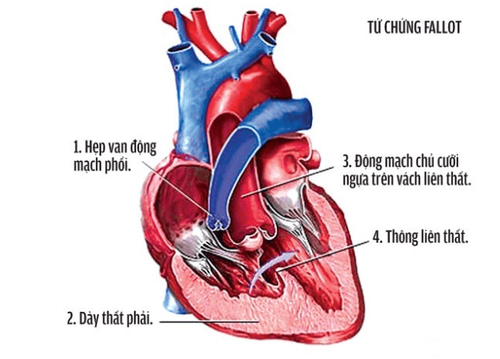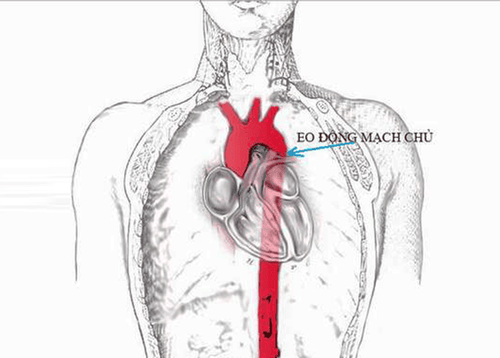This is an automatically translated article.
The article is professionally consulted by Master, Doctor Pham Van Hung - Department of Medical Examination & Internal Medicine - Vinmec Danang International General Hospital.
Congenital heart defects occur in about 1% of newborns. Most people with congenital heart defects are able to live into adulthood, in which the cause is unknown. Some may be hereditary, because the mother is infected with a virus or uses alcohol and drugs during pregnancy.
1. What is congenital heart disease?
Congenital heart disease is a structural defect of the heart that occurs during the first weeks of pregnancy during the period when the heart is forming.
2. Types of congenital heart defects
Here are some common anomalies:2.1 Obstructive aortic stenosis Aortic valve stenosis: The aortic valve between the left ventricle and the aorta does not develop fully and narrows, preventing blood pumping. from the left ventricle into the aorta. A normal aortic valve has three leaflets, but a stenotic valve may have only one or two leaflets.
Possible symptoms are chest pain, fatigue, dizziness, fainting. Most children with aortic stenosis have no symptoms. Mild stenosis may also worsen over time, requiring surgery or percutaneous intervention with a catheter to correct the blockage or possibly replace the prosthetic valve if necessary.
Pulmonary stenosis: The pulmonary valve is located between the pulmonary artery and the right ventricle. When the valve opens, blood is pumped from the right ventricle to the lungs. When the pulmonary valve is narrowed, the heart has to pump harder than usual to bypass the narrowing. The obstruction can be corrected by percutaneous balloon dilatation. Sometimes some patients need open heart surgery.
2-piece aortic valve: Babies are born with only 2 pieces of aortic valve (normally 3 pieces). The narrowed valve impedes the pumping of blood from the left ventricle to the aorta, and blood often flows back into the left ventricle. This malformation is usually detected in adulthood.
Subaortic stenosis: It is a narrowing of the left ventricle just below the aortic valve, narrowing the ejection tract of the left ventricle. This condition increases the left ventricular load. Subaortic stenosis may be congenital or due to cardiomyopathy.
Coarctation of the aorta: Narrowing of the aorta obstructs blood flow to the lower body and raises blood pressure above the narrowing. Coarctation of the aorta are usually asymptomatic at birth, but they can manifest as early as the first week postpartum.
Surgery is required if the patient has severe symptoms such as hypertension and congestive heart failure. A small number of severe cases are detected only in adulthood. The disease needs to be detected and treated early because long-term consequences can be serious.
2.2 Septic defects Some congenital heart defects allow blood to flow between the right and left chambers of the heart. It occurs due to the appearance of a hole in the septum between the two chambers of the heart. Atrial septal defect (TLN): The septum between the left atrium and the right atrium has a hole that allows blood to flow between the two atria (normally blood flows from the atria to the ventricles). Atrial septal defects in children are usually asymptomatic. The stoma can be closed by surgery or by percutaneous intervention with a catheter.
Ventricular septal defect (TLT): The septum between the right and left ventricles is defective during formation, creating a septal defect. This opening allows blood to flow from the left ventricle to the right ventricle (because left ventricular pressure is higher than right ventricular pressure), increasing blood flow from the right ventricle to the lungs.
This condition is prolonged will increase pulmonary artery pressure. Some ventricular septal defects may close on their own, but others may require surgery or percutaneous intervention with a catheter.
Congenital cyanotic heart disease: A heart disease in which the blood pumped out to the body contains less oxygen than normal. This condition causes the skin to turn bluish-purple. Infants with cyanosis are often referred to as "blue babies."
Tetralogy of Fallot: Tetralogy of Fallot is characterized by 4 defects, including:
The ventricular septal defect allows blood to pass from the right ventricle through the left ventricle without reaching the lungs. A narrowing at or just below the pulmonary valve that partially obstructs the flow of blood from the right ventricle to the lungs. Right ventricular thickening. The aorta is located directly above the septal defect. Tetralogy of Fallot is the most common congenital heart defect that causes cyanosis in children older than 2 years of age. Most children with tetralogy of Fallot need open-heart surgery before school age to close the ventricular septal defect and remove impediments to blood flow to the lungs. These children need lifelong health monitoring.

Small right ventricle. Large left ventricle. Pulmonary circulation is reduced. Cyanosis. A bypass surgery is needed to increase blood flow to the lungs.
Transposition of the great arteries: In this malformation, the positions of the pulmonary artery and the aorta are reversed:
The aorta originates in the right ventricle, so most of the blood returning to the heart from the body is pumped back out without going to the lungs.
The pulmonary arteries originate in the left ventricle, so most of the blood returning to the heart from the lungs is pumped back up to the lungs.
This deformity requires immediate medical intervention.
2.3 Other heart defects Hypoplastic left heart syndrome: Defective left heart development including left ventricle, aortic valve, aorta, and mitral valve underdevelopment. Blood reaches the aorta through the ductus arteriosus, and if the duct closes as it should, the baby will die.
Babies usually show no abnormalities at birth, but within a few days after birth the ductus is closed and the baby will show abnormalities such as ash-gray skin, shortness of breath, refusal to suckle, and decreased pulse in the legs. or lost. Surgical treatment is necessary.
And ductus arteriosus: Normally after birth, the ductus arteriosus (an artery connecting the aorta and pulmonary artery) will close. If the ductus arteriosus does not close, the baby will have a ductal malformation. This malformation allows blood to mix between the pulmonary artery and aorta, increasing blood flow to the lungs, gradually causing pulmonary hypertension. This defect is common in premature babies.
Ebstein malformation: In this defect, there is a downward displacement of the tricuspid valve (separate between the right atrium and the right ventricle). As a result, the right atrium will be larger and the right ventricle will be smaller than normal. This defect can cause arrhythmias and heart failure. It is often associated with an atrial septal defect.
Congenital heart defects are the most common and the leading cause of death among birth defects in children. Today, with advances in diagnosis and treatment, the survival rates of complex congenital heart disease cases have significantly increased.
Master, Doctor Pham Van Hung has 30 years of experience in examination and treatment of internal diseases, especially in Cardiology: coronary arteries, heart failure, heart valves, arrhythmias. ..Master, Dr. Hung used to hold the position of Deputy Head of Cardiology Department and Head of Interventional Cardiology Unit at Da Nang General Hospital and is currently working at Department of Medical Examination and Internal Medicine, Internal Cardiology, and Cardiology. Interventional circuit at Vinmec Da Nang International General Hospital.
Please dial HOTLINE for more information or register for an appointment HERE. Download MyVinmec app to make appointments faster and to manage your bookings easily.














